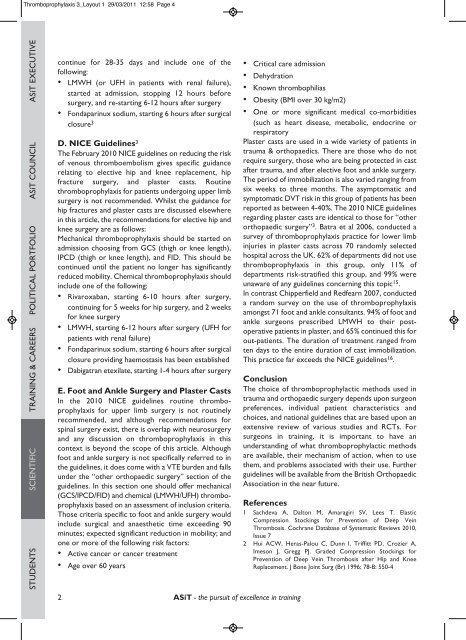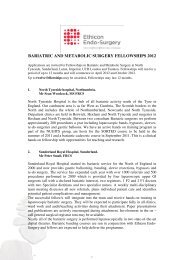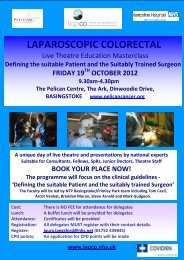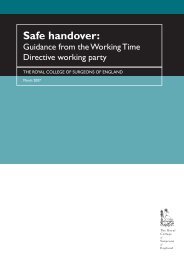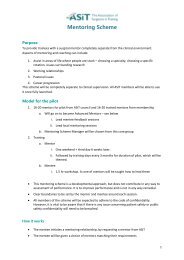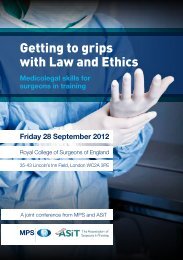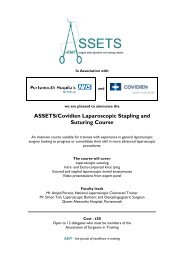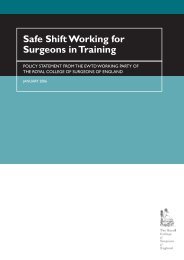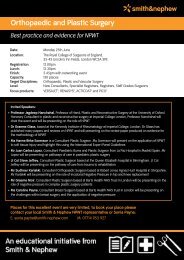ASiT Yearbook 2011 - The Association of Surgeons in Training
ASiT Yearbook 2011 - The Association of Surgeons in Training
ASiT Yearbook 2011 - The Association of Surgeons in Training
You also want an ePaper? Increase the reach of your titles
YUMPU automatically turns print PDFs into web optimized ePapers that Google loves.
<strong>ASiT</strong> EXECUTIVE<br />
Thromboprophylaxis 3_Layout 1 29/03/<strong>2011</strong> 12:58 Page 4<br />
STUDENTS<br />
SCIENTIFIC TRAINING & CAREERS POLITICAL PORTFOLIO <strong>ASiT</strong> COUNCIL<br />
cont<strong>in</strong>ue for 28-35 days and <strong>in</strong>clude one <strong>of</strong> the<br />
follow<strong>in</strong>g:<br />
• LMWH (or UFH <strong>in</strong> patients with renal failure),<br />
started at admission, stopp<strong>in</strong>g 12 hours before<br />
surgery, and re-start<strong>in</strong>g 6-12 hours after surgery<br />
• Fondapar<strong>in</strong>ux sodium, start<strong>in</strong>g 6 hours after surgical<br />
closure 3<br />
D. NICE Guidel<strong>in</strong>es 3<br />
<strong>The</strong> February 2010 NICE guidel<strong>in</strong>es on reduc<strong>in</strong>g the risk<br />
<strong>of</strong> venous thromboembolism gives specific guidance<br />
relat<strong>in</strong>g to elective hip and knee replacement, hip<br />
fracture surgery, and plaster casts. Rout<strong>in</strong>e<br />
thromboprophylaxis for patients undergo<strong>in</strong>g upper limb<br />
surgery is not recommended. Whilst the guidance for<br />
hip fractures and plaster casts are discussed elsewhere<br />
<strong>in</strong> this article, the recommendations for elective hip and<br />
knee surgery are as follows:<br />
Mechanical thromboprophylaxis should be started on<br />
admission choos<strong>in</strong>g from GCS (thigh or knee length),<br />
IPCD (thigh or knee length), and FID. This should be<br />
cont<strong>in</strong>ued until the patient no longer has significantly<br />
reduced mobility. Chemical thromboprophylaxis should<br />
<strong>in</strong>clude one <strong>of</strong> the follow<strong>in</strong>g:<br />
• Rivaroxaban, start<strong>in</strong>g 6-10 hours after surgery,<br />
cont<strong>in</strong>u<strong>in</strong>g for 5 weeks for hip surgery, and 2 weeks<br />
for knee surgery<br />
• LMWH, start<strong>in</strong>g 6-12 hours after surgery (UFH for<br />
patients with renal failure)<br />
• Fondapar<strong>in</strong>ux sodium, start<strong>in</strong>g 6 hours after surgical<br />
closure provid<strong>in</strong>g haemostasis has been established<br />
• Dabigatran etexilate, start<strong>in</strong>g 1-4 hours after surgery<br />
E. Foot and Ankle Surgery and Plaster Casts<br />
In the 2010 NICE guidel<strong>in</strong>es rout<strong>in</strong>e thromboprophylaxis<br />
for upper limb surgery is not rout<strong>in</strong>ely<br />
recommended, and although recommendations for<br />
sp<strong>in</strong>al surgery exist, there is overlap with neurosurgery<br />
and any discussion on thromboprophylaxis <strong>in</strong> this<br />
context is beyond the scope <strong>of</strong> this article. Although<br />
foot and ankle surgery is not specifically referred to <strong>in</strong><br />
the guidel<strong>in</strong>es, it does come with a VTE burden and falls<br />
under the “other orthopaedic surgery” section <strong>of</strong> the<br />
guidel<strong>in</strong>es. In this section one should <strong>of</strong>fer mechanical<br />
(GCS/IPCD/FID) and chemical (LMWH/UFH) thromboprophylaxis<br />
based on an assessment <strong>of</strong> <strong>in</strong>clusion criteria.<br />
Those criteria specific to foot and ankle surgery would<br />
<strong>in</strong>clude surgical and anaesthetic time exceed<strong>in</strong>g 90<br />
m<strong>in</strong>utes; expected significant reduction <strong>in</strong> mobility; and<br />
one or more <strong>of</strong> the follow<strong>in</strong>g risk factors:<br />
• Active cancer or cancer treatment<br />
• Age over 60 years<br />
2<br />
<strong>ASiT</strong> - the pursuit <strong>of</strong> excellence <strong>in</strong> tra<strong>in</strong><strong>in</strong>g<br />
• Critical care admission<br />
• Dehydration<br />
• Known thrombophilias<br />
• Obesity (BMI over 30 kg/m2)<br />
• One or more significant medical co-morbidities<br />
(such as heart disease, metabolic, endocr<strong>in</strong>e or<br />
respiratory<br />
Plaster casts are used <strong>in</strong> a wide variety <strong>of</strong> patients <strong>in</strong><br />
trauma & orthopaedics. <strong>The</strong>re are those who do not<br />
require surgery, those who are be<strong>in</strong>g protected <strong>in</strong> cast<br />
after trauma, and after elective foot and ankle surgery.<br />
<strong>The</strong> period <strong>of</strong> immobilization is also varied rang<strong>in</strong>g from<br />
six weeks to three months. <strong>The</strong> asymptomatic and<br />
symptomatic DVT risk <strong>in</strong> this group <strong>of</strong> patients has been<br />
reported as between 4-40%. <strong>The</strong> 2010 NICE guidel<strong>in</strong>es<br />
regard<strong>in</strong>g plaster casts are identical to those for “other<br />
orthopaedic surgery” 3 . Batra et al 2006, conducted a<br />
survey <strong>of</strong> thromboprophylaxis practice for lower limb<br />
<strong>in</strong>juries <strong>in</strong> plaster casts across 70 randomly selected<br />
hospital across the UK. 62% <strong>of</strong> departments did not use<br />
thromboprophylaxis <strong>in</strong> this group, only 11% <strong>of</strong><br />
departments risk-stratified this group, and 99% were<br />
unaware <strong>of</strong> any guidel<strong>in</strong>es concern<strong>in</strong>g this topic 15 .<br />
In contrast Chipperfield and Redfearn 2007, conducted<br />
a random survey on the use <strong>of</strong> thromboprophylaxis<br />
amongst 71 foot and ankle consultants. 94% <strong>of</strong> foot and<br />
ankle surgeons prescribed LMWH to their postoperative<br />
patients <strong>in</strong> plaster, and 65% cont<strong>in</strong>ued this for<br />
out-patients. <strong>The</strong> duration <strong>of</strong> treatment ranged from<br />
ten days to the entire duration <strong>of</strong> cast immobilization.<br />
This practice far exceeds the NICE guidel<strong>in</strong>es 16 .<br />
Conclusion<br />
<strong>The</strong> choice <strong>of</strong> thromboprophylactic methods used <strong>in</strong><br />
trauma and orthopaedic surgery depends upon surgeon<br />
preferences, <strong>in</strong>dividual patient characteristics and<br />
choices, and national guidel<strong>in</strong>es that are based upon an<br />
extensive review <strong>of</strong> various studies and RCTs. For<br />
surgeons <strong>in</strong> tra<strong>in</strong><strong>in</strong>g, it is important to have an<br />
understand<strong>in</strong>g <strong>of</strong> what thromboprophylactic methods<br />
are available, their mechanism <strong>of</strong> action, when to use<br />
them, and problems associated with their use. Further<br />
guidel<strong>in</strong>es will be available from the British Orthopaedic<br />
<strong>Association</strong> <strong>in</strong> the near future.<br />
References<br />
1 Sachdeva A, Dalton M, Amaragiri SV, Lees T. Elastic<br />
Compression Stock<strong>in</strong>gs for Prevention <strong>of</strong> Deep Ve<strong>in</strong><br />
Thrombosis. Cochrane Database <strong>of</strong> Systematic Reviews 2010,<br />
Issue 7<br />
2 Hui ACW, Heras-Palou C, Dunn I, Triffitt PD, Crozier A,<br />
Imeson J, Gregg PJ. Graded Compression Stock<strong>in</strong>gs for<br />
Prevention <strong>of</strong> Deep Ve<strong>in</strong> Thrombosis after Hip and Knee<br />
Replacement. J Bone Jo<strong>in</strong>t Surg (Br) 1996; 78-B: 550-4


